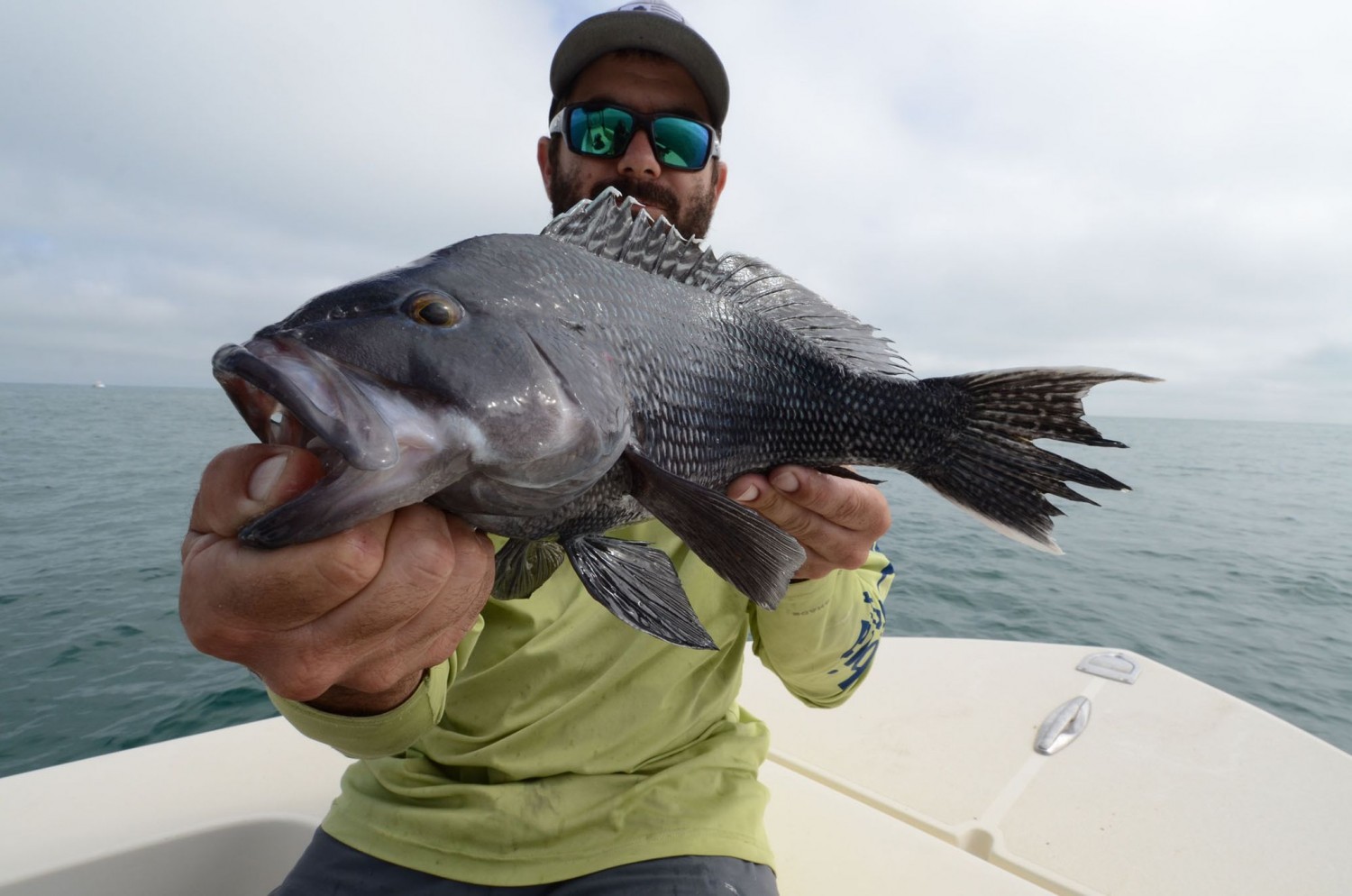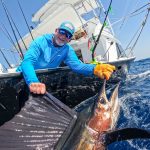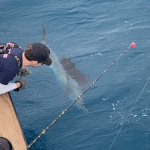Article Courtesy: sportfishingmag.com | Originally Published: 12/15/20 | Click here for original article
Four Ways to Fish a Wreck
In the deserted expanse that covers most of the sea floor, any structure provides an oasis for fish and a target for anglers. Shipwrecks and artificial reefs host encrusting organisms, which jumpstart the food chain — drawing everything from baitfish to predators that swim throughout the water column.
Tautog or grouper might be hiding inside the wreck, snapper might swim above it, and king mackerel could be chasing bait near the surface. Anglers must prepare for any kind of action with the right tackle and techniques.
Bottom Bouncing
To target smaller bottomfeeders and wreck residents like sea bass and triggerfish, anglers use a two-hook bottom rig.
Start with an arm’s length of 50-pound fluorocarbon, which virtually disappears underwater and is stiffer and more abrasion resistant than monofilament.
Tie a surgeon’s loop at the end of the leader, and then tie two dropper loops about 12 inches apart. Attach a bank sinker to the loop, and affix 3/0 to 5/0 long-shank hooks to the dropper loops. Tie the tag end of the leader to a swivel. Tie the leader to 50-pound braid mainline on a medium-heavy-action conventional outfit.
To entice larger fish hiding in the wreck, use a beefed-up Carolina rig, which allows the line to pass through the sinker. When a fish picks up the bait and swims away, it doesn’t feel the weight at first.
The size and weight of the rig depends on the size of the bait and target fish. The hook should be small enough to hide in the bait and large enough to hold a big fish. Start with a 2/0 to 8/0 circle hook and attach to it a 12- to 18-inch length of 50- to 80-pound fluorocarbon.
Slide a 2- to 8-ounce egg sinker over the 50- to 80-pound braided mainline, followed by a small, plastic bead. To the end of the braid, tie a 150-pound-test barrel swivel. Attach the hook and leader to the swivel.
Popular baits include cut fish, squid, crabs and shrimp. Some fish, like tautog, can be finicky; black sea bass and trigger fish don’t seem to care. Most importantly, make sure the bait is fresh and tough. Use chunks with skin and bone to help keep it on the hook; pieces should be large enough to hide the hook, but not so big the fish can’t eat it. A smaller chunk drops to the bottom faster and stays there longer.
When drifting baits across the wreck, try to keep the line straight up and down. Bounce the rod tip to move the rig off the bottom, checking to maintain contact with the structure and keep the rig from snagging the wreck. If the bait rig drifts away from the boat, reel in and drop again. Periodically check the bait.
If you anchor, you don’t fish as much of the structure, but it’s the best way to target fish living in the wreck or to chum for predators. The rule of thumb: Use seven times as much anchor rode as the depth. In 100 feet, that means 700 feet of anchor line.
Motor upwind and upcurrent from the wreck, drop the anchor and chain, then drift back over the structure. Once the anchor comes tight, pull in line to move the boat over the structure. To perfectly place the boat over the wreck, set a second anchor at a 180-degree angle from the windward anchor.
Of course, an easier way to secure the boat over the wreck involves an offshore, long-shaft GPS trolling motor or an outboard boat-control system such as Helm Master from Yamaha. Simply press a button and the trolling motor or engines hold the boat in place.
Dance a Jig
One of the biggest advancements in wreck fishing came with the development of vertical jigs. Dropping a long, thin, lead spoon to the bottom and working it quickly back to the boat can be a deadly tactic for many fish species.
Vertical jigs prove especially effective when a school of fish shows up on the fishfinder. Use a metered braided line, which changes color every six feet, to drop the jig to the depth where the fish are holding. When the lure reaches the fish, crank like crazy while rhythmically jerking the rod tip.
To rig up, start with a medium-heavy, 6-foot-6-inch jigging rod. The shorter rod makes it easier to jig quickly. A rod with parabolic action bends to the grips, imparting more erratic movement to the jig. Spool a high-speed reel with 50- to 80-pound braid and add 6 feet of equal strength fluorocarbon leader ahead of the jig.
A slightly different technique—slow-pitch jigging—has recently captured attention. Instead of working a larger, heavier jig at top speed, this tactic requires the angler to slow down, allowing the shape of the lure to provide the enticing action. Examples of slow-pitch jigs include Shimano’s Butterfly Flat Fall, Williamson’s Crippled Herring and Savage Gear’s Squish Jigs.
Enthusiasts recommend a light-action, 6-foot, parabolic rod. Some anglers go with a conventional reel for better line control, however many choose a spinning reel, which provides greater sensitivity and virtually no resistance on the line as the light lure drops to the bottom.
To prowl the bottom and probe every nook and cranny of the wreck, turn to leadhead jigs and bucktails. Not only do these tactics spark bites from aggressive predators, but they allow anglers to fish deep water with light tackle.
Fish the jig off a 7-foot, medium-action spinning or conventional combo with 20-pound braid. Attach a 6-foot length of 30-pound fluorocarbon leader to the mainline with a line-to-line knot, such as a slim beauty.
To avoid snagging the wreck, use the lightest jig that will reach bottom. Bounce the jig along the bottom and across the wreck. A bucktail and strip of cut bait will swim seductively, fooling flounder, sea bass and triggerfish.
For tautog, choose a 2- to 3-ounce leadhead with a short-shank 3/0 to 5/0 hook. Attach a chunk of crab or clam to the hook and drop the jig deep into the structure.
On a Troll
Trolling over and around wrecks can produce king mackerel, dolphin, wahoo, sailfish and tuna. Pull plugs or rigged baits at 6 to 16 knots to elicit bites from predators. Make a figure-8 over the wreck, and then make a large circle around the perimeter to find fish hanging off the wreck.
Tackle choices depend on the size of the lure or bait and the trolling speed. Use 20-pound tackle for small ballyhoo but a 50- or 80-pound setup for horse ballyhoo. To troll big lures at 16 knots for wahoo requires braided mainline while rigged baits and artificial lures work best with mono, which absorbs the shock of a striking fish and reduces tangles when the lines cross.
Since fish on a wreck often congregate in one area, slow-trolling live or rigged baits keeps the offerings in the target area longer. Motoring around the wreck, dangling a live bait seductively over the structure, puts an easy meal directly over the fish.
To add a kite bait to the menu, set out the live baits while anchored over the wreck. Then slowly work the spread in a figure eight, with the wind across the bow of the boat.
Troll live baits using a 20-pound combo spooled with 40-pound braid and a 100-yard topshot of 20-pound monofilament. Add a 20-foot leader of 30-pound clear mono to the topshot with a line-to-line knot such as a Bimini to a no-name. For king mackerel and other ambush attackers, use a single-strand wire stinger rig with No. 4, 4-X strong treble hooks. Sharp-sighted fish, like tuna or billfish require a single circle hook.
Use only about 5 pounds of drag, and let the fish run with the bait. Hooking a speeding predator attacking a live prey at breakneck speed takes luck more than skill.
Casting Call
While bottomfishing, jigging or dragging a live bait, wreck anglers must also be ready to cast to breaking fish. When the surface of the water turns frothy with blitzing predators, or a marauding hunter swims up to the boat, grab a pitch bait and make a cast.
Speed counts. Store the casting outfit in easy reach, ready to deploy. Keep a live pitch bait in a bucket of water or stage the rod next to the livewell. A rod with a bucktail, jig or swimming plug should live in the leaning-post rocket launcher. To fire a fast cast, use a beefy medium to medium-heavy spinning combo. Even if the fish drop below the surface, it never hurts to make a cast.
Wherever the wreck, be ready for anything. Keep the right rod-and-reel combos rigged for jigging, bait, trolling and casting. When the sea bass attack baits at the bottom, hungry snapper school 50 feet down, or sailfish cut the surface, there’s no time to lose.






